Running a business. Making a product. Impressing your audience.
These take a lot of deliberation.
Aspiring entrepreneurs need clarity and a lot of insights for that to happen.
That is where key performance indicators and OKRs come into picture.
They bridge the gap between different departments and give ideas a benchmark to work against and match.
But, aren’t they the same?
And do they really bring about any significant change?
This blog addresses those and much more.
Let’s jump into it.
What are KPIs?
Investopedia defines KPIs as “a set of quantifiable measures that a company uses to gauge its performance over time.” As ‘key’ performance indicators, they do not account for every possible performance metric out there.
Indicators that are chosen to be tracked are ones that clearly demonstrate if a company is achieving key business objectives. These can range from reaching sales targets, bringing in website traffic (low-level) to brand perception or market cap (high-level).
How are KPIs useful?
The most general usage of KPIs is by managers to set, measure, and manage targets and goals for everyone in an organisation. This helps them review employee performance, ensuring that everything is going as per the plans.
Achieving a flatline of continuous work is just one possibility; via KPIs, new measures and ideas can be generated and tested as well.
KPIs work both ways — they can track individual/per department performance (thus helping in framing remedial actions) and overall company performance, paving the way for strategic maneuvers.
Overall,
- KPIs make vision and strategy actionable.
- KPIs bring transparency to performance to all levels.
- KPIs bring efficiency and coherence to management communication.
History of KPIs
KPIs have been a long-standing framework to test and measure strategies and performance in organizations big and small.
Measuring performance as a concept began in the early 20th century as managers wanted to ensure that they are getting work worth what they spend.
‘Return on investment’ or ROI as it is known now can only be accurately measured when every aspect of the business has a predictable indicator. Luckily, since manufacturing and 8-hour workdays made the whole assembly line continuous, indicators emerged on their own.

But tracking performance on the mere basis of whether it is bringing immediate returns is both shortsighted and harmful for the employees. A better method was required.
The founding basis of holistic performance measurement is the balanced scorecard, a method so simple and effective that it is still used today at many enterprises.
Types of KPIs
- Leading indicators: Any KPI that clearly tells you if a certain trend is emerging. Leading performance indicators forecast output and revenue, and look out for negative or bad trends.
- Lagging indicators: Any KPI that tells you why a certain trend emerged. Such indicators are always retrospective. They help in framing better leading indicators.
- Quantitative indicators: Any KPI that tracks ‘how much’ of something has been done. Overall output, revenue, work hours, web traffic — such things are quantitative performance indicators.
- Qualitative indicators: Any KPI that tracks an attribute or factor of something. Qualities such as efficacy, growth, motivation — such things are either a complex equation or based on a definition that differs from company to company.
Examples of KPIs
Customer Lifetime Value (CLV)
It takes a lot of time, effort, and resources to acquire a single customer. All of that expenditure pays off when the customer has a great lifetime value, i.e., they subscribe to your product indefinitely, and also try out other offerings.
Customer Lifetime Value is a lagging KPI; over a period of a year or more, you see that customers with the highest lifetime value have provided you with a stable revenue.
Customer Acquisition Cost (CAC)
This metric tracks the overall expenditure by a company to acquire a single customer. A company can never become profitable if its CAC remains higher than or equal to its CLV.
Customer Acquisition Cost is a leading KPI; you can predict how long it would take you to break even or reach profitability.
What are OKRs?
‘Objectives and Key Results’ is a consolidated goal-setting tool used by teams, managers, senior employees, and entrepreneurs to set challenging, ambitious goals with measurable results.
OKRs help you track progress, sure, but they also help in bringing alignment and a sense of shared purpose within everyone.
OKRs are made out of two components — the objectives and the key results.
Objectives, simply put, are anything that needs to be achieved in order to grow the company. Ideally, objectives are significant, action-oriented, and clear.
Key results are metrics that set the benchmark for your objectives and help you track them on a regular basis. This component can either be framed for your unique need or be substituted by a KPI.
Key results leave no room for doubt or excuses — the result is either there or not.
OKRs are generally set for a quarter but they can be for any period of time.
How are OKRs useful?
OKRs bring harmony to all the shifting gears in your company. Being a management framework, it constantly acts as a reminder for your company’s objectives or product vision.
It also helps in prioritizing and making sure the things that matter the most are getting the most effort.
During extreme pressure-situations, it acts as a compass for employees so that they can decide what they should work on. This is why organizations should never have more than three OKRs running at the same time.
Ultimately, it helps convert the potential of an individual/team/product into reality. By putting down an objective and measuring its progress, you ensure that it is constantly being worked upon.
History of OKRs
As the story goes, OKRs as a concept were created by Andy Grove (key researcher and influencer at Intel) who taught to John Doerr.
Doerr took it a step further, giving them a name and also writing a book about them — ‘Measure What Matters’.
A key turning point that resulted in OKRs becoming a famous methodology was when Doerr introduced the philosophy to Google’s founders in 1999. Gathered around a ping-pong table which doubled as a boardroom table, Doerr presented a PowerPoint to the young founding team, which included Larry Page, Sergey Brin, Marissa Mayer, Susan Wojcicki, and Salar Kamangar.
This is apparently what his PowerPoint looked like.
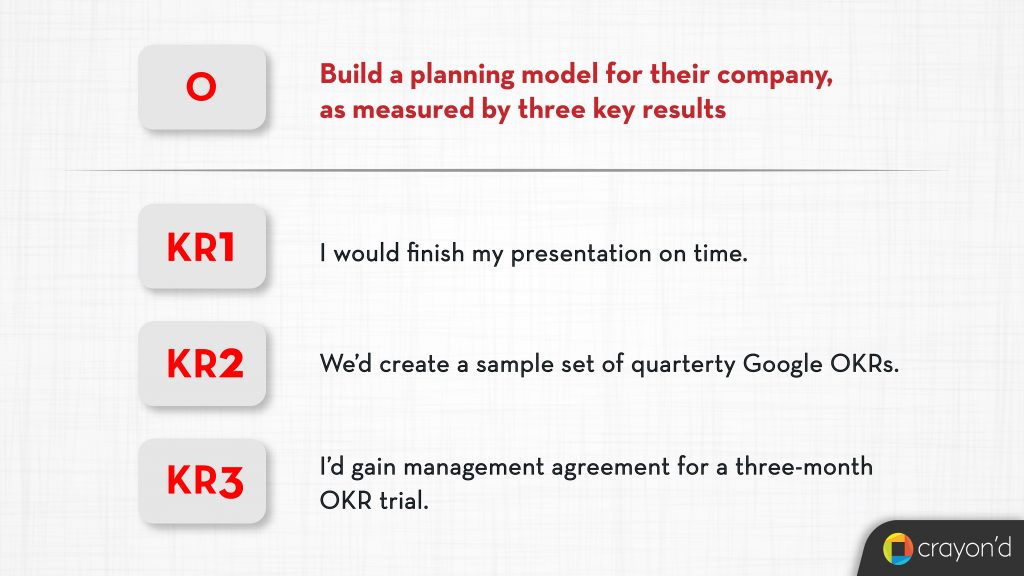
Writing your own OKRs
Every company has its own definition of what success and growth looks for them. The perfect OKR statements are the ones that are tailored for your company’s business objectives and motivations.
? Applying a simple four-step approach will help:
- Determining objectives
- Defining success
- Deciding what to measure
- Using the SMART framework to write your own OKRs.
Determining objectives
Here, you take your raw goals and convert them into objectives for your KPIs. Objectives are strategic, meaning that they stem from and are driven by strategy and new ideas. For example, as an entrepreneur, you might want to sell more of your product.
Your objective: Increasing the number of leads in the sales pipeline.
Defining Success
Now that you have your objective in place, you need to define what its success looks like.
i.e., What is the attribute that if achieved, would complete the objective?
If your objective is to increase the number of sales leads, then success would be
- Being able to generate more leads than usual regularly
- Being able to get in touch with the new leads
This works: leads that are generated but not contacted are not new and they do not make for a pipeline at all.
Deciding what to measure
Defining success is just the initial part. Now, you would have to measure it.
There are two parts to this: the initial alignment and the ongoing measurement.
For the former, you have to be granular about your objective. You would have to take every variable and define them.
“What does a lead mean? Are they potential clients or prequalified by the marketing team? Should the first touchpoint result in anything?” are some relevant questions for our example objective.
For the latter, you have to compare the numbers before and after the introduction of the OKR. You can do this manually, using a spreadsheet, or any OKR tracking software.
SMART your OKR statement
Your key performance indicators need to be:
- Specific
- Measurable
- Attainable
- Relevant
- Time-bound
Following a simple structure like ‘Action; Detail Value; Deadline’ can help you. For example — “Increase new HubSpot lead profiles to 40,000 people by 31st December 2019.”
To revert to our sales example, make sure that the increment is attainable. If your sales team was generating 50 leads per day, then increasing it to 70 would not be super difficult.
The OKR statement for that would be “Increase new sales leads to 70 by 30th November”.
Make your OKR statement actionable
Framing the statement is just the first step to getting the ball rolling. The next step is to break your OKR statement down into its core components — the objective and the key results.
Here is an example.
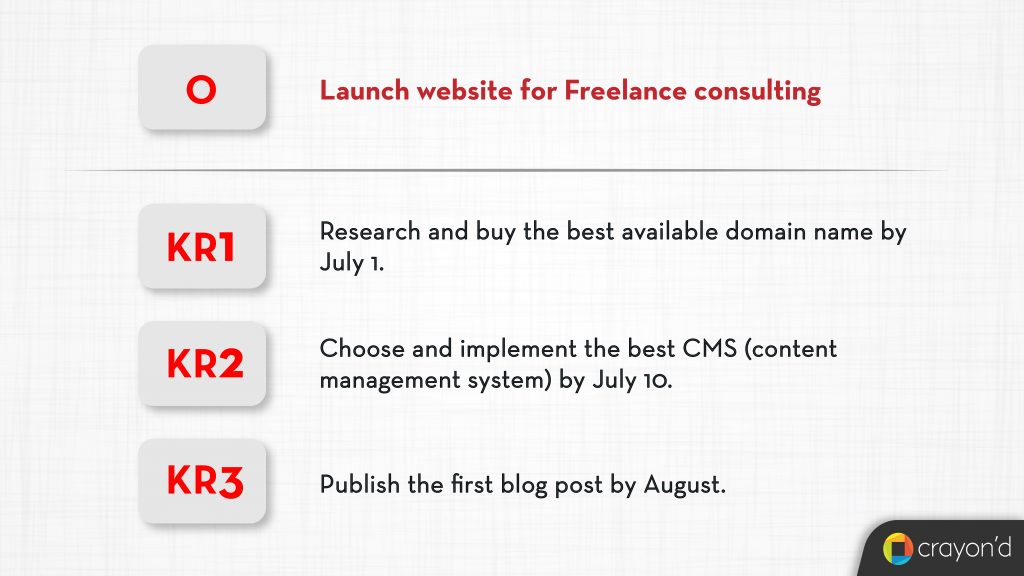
Applying this to your recurrent sales lead example would turn it into:
O: Increase sales leads for our product
KR1: Increasing marketing efforts to generate more leads
KR2: Working on new promotional material
KR3: Releasing a new brochure by October
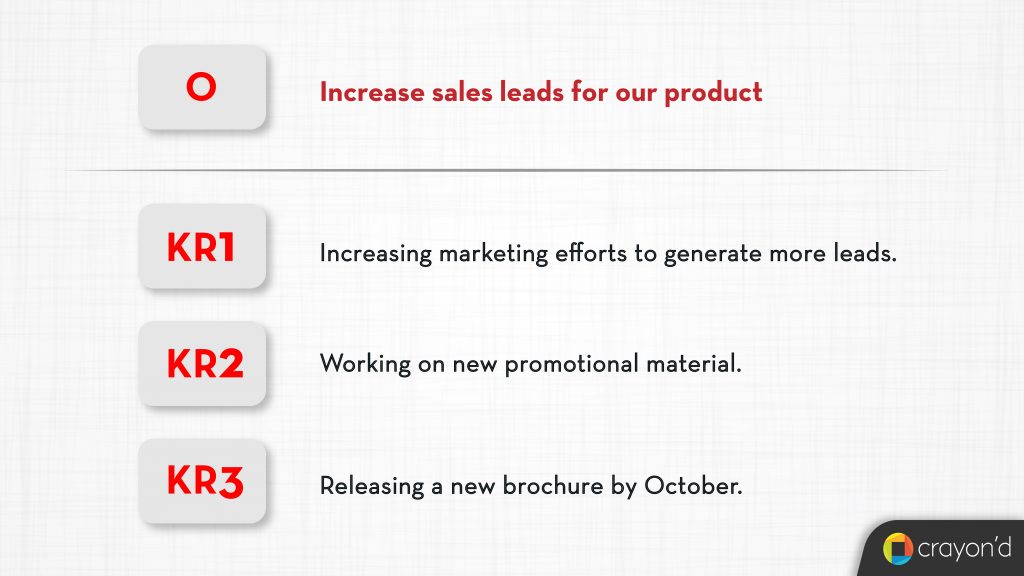
Important principles for your OKRs
OKRs need to be simple and agile
OKRs are set minimum for a month and maximum for a quarter. OKRs generally do not exceed the three-month window because they are supposed to lend agility to an organization.
When OKRs are set just for a quarter, an organization gets to assess trends and generate new OKRs, all the while challenging themselves to become better.
Complex OKRs that look like mission statements are most likely to be ineffective because neither do the employees relate to them nor are they achievable.
Ultimately, OKRs aim for exponential growth using minimal linear investment, say, one hour of your time or 1% of your budget for a small key result. Thus, anything that asks for too much needs to be reassessed and rewritten.
OKRs are specific
OKRs that are set for the entire company are not the same OKRs that a specific department should try to achieve. i.e., OKRs do not trickle down.
Instead, take the high-level objective and convert it into your specific objective and then write your OKRs.
OKRs oils the collaborative engine
OKRs make it easy to know who makes what kind of contribution. Such immense transparency encourages everyone to contribute without worrying.
Since OKRs also align an entire team toward a specific objective, it becomes clear that everyone needs to work together to accomplish that.

Other key points
- OKRs are not a tool for evaluating employees. At the maximum, it can probably tell you if a person is agile or not, but it does not account for other factors such as creativity or emotional intelligence or resourcefulness.
- Too many OKRs do not mean anything. Like the saying goes, if everything is a priority, then nothing is.
Examples of OKRs
High-level
Objective: Expand into the American market and capture 15% of market share from our competitors in one year
Key Results:
- Conduct comprehensive market research and SWOT analysis report by Jan 31st
- Hire native English sales executives by Feb 20th
- Launch American-specific MVP version of product with top 5 requested features by March 1st
Low-level
Objective: Strengthen brand as leader in space to increase monthly subscriptions
Key Results:
- Secure 5 industry influencers for branding campaign in Q2
- Grow social media followers from 1,000 to 2,000 by Q2
- Boost NPS score over 8.0 by end of Q2
- Publish 5 enterprise customer video testimonials by Q2
KPIs are not OKRs
A common misconception is that KPIs and OKRs are the same.
While both aim at translating strategic goals into actionable items, they are far different from each other.
Or rather, it can be said that one arises from the other.
Every startup has a vision for its product, which is then broken down into long-term goals.
These goals remain vague and lack strategy.
To infuse them with ideas or to make them actionable, you would use OKRs.
As a methodology, OKRs allow you to convert your goals into achievable objectives with trackable key results.
KPIs are just another metric that go along with the key results to show you if you are on track or not.
Differences between OKRs and KPIs
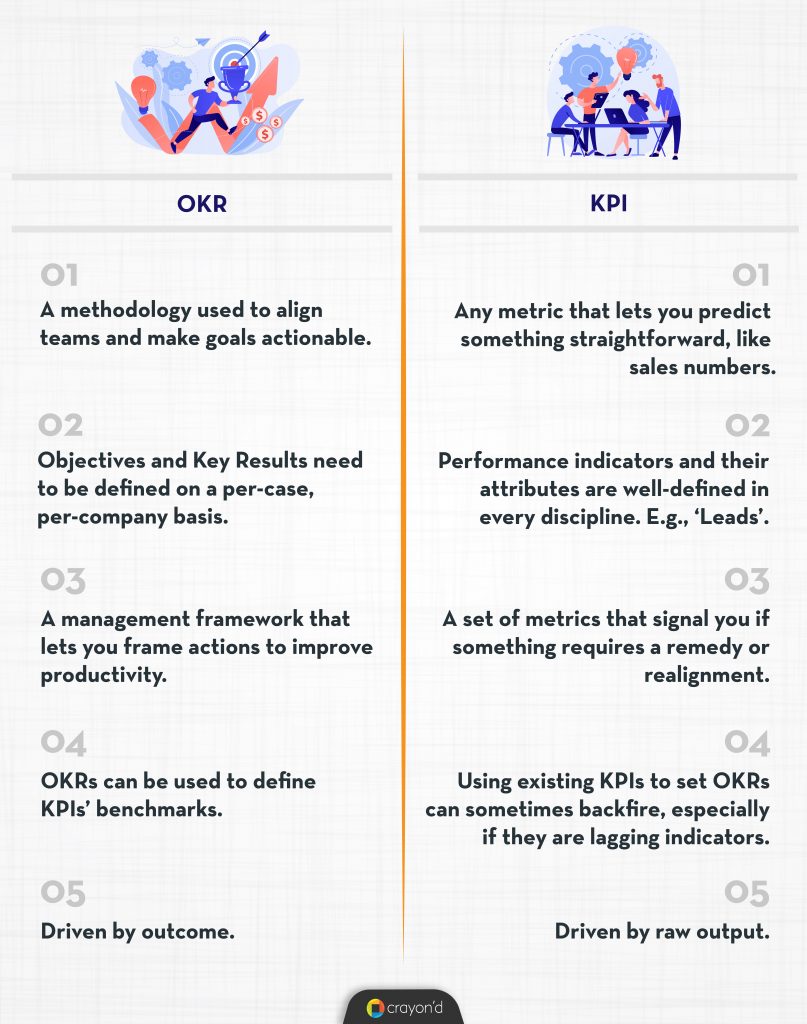
Conclusion
Making high-level strategies work and ensuring that low-level activities happen regularly require a lot of tools.
OKRs and KPIs are just one among the bunch of enablers.
Understanding the difference between them and properly framing your objectives is the surest way to get work done with efficacy.
All enablers however stem from just one simple principle: what is it that truly matters?
For your product or business, what are the key elements that can drive the most growth.
Digital product agencies are known for bringing the best out of product-ideas.
Try one out and see the potential for change yourself.


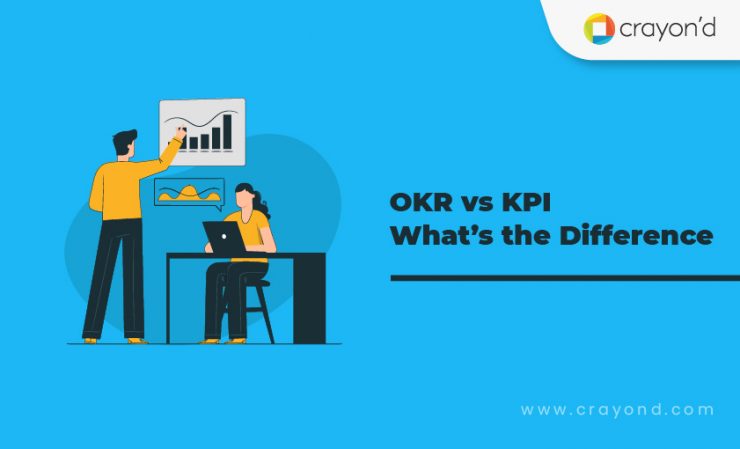




Add comment